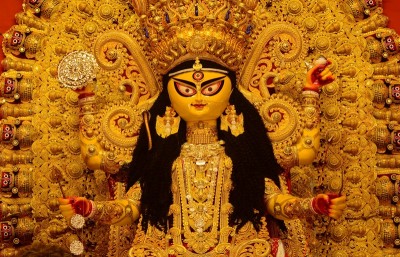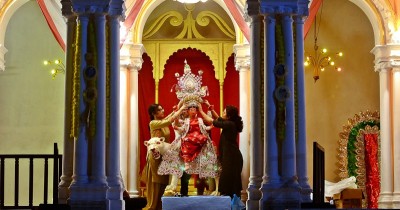Photo Essay: Kolkata trams finally lose the turf battle
It was only last year that Kolkata's trams celebrated 150 years of their rollercoaster journey in the eastern metropolis. For decades the city's signature streetcars were fighting a grim survival battle despite all ado over heritage.
But the verdict is out- failing miserably to modernise and repurpose it, the West Bengal government has decided to discontinue the service, wiping out with the decision a legacy of the city fast turning into a relic of its past glory.
Is the decision to discontinue tram driven by just pragmatism or any ulterior motive? Tram lovers are asking this question. Photo by Avishek Mitra
However, the route between Esplanade and Maidan, will remain operational for its tourist attraction offering a glimpse of the magnificent Victoria Memorial and the green Maidan park.
The signature ceiling fan of a Kolkata tram. Photo by Avishek Mitra
Trams have been part of Kolkata's essential urban landscape since 1873. But the decades of apathy and inattention despite being a symbol of the city's colonial and post colonial heritage dealt a death blow.
Tram lovers and activists are protesting the government decision. Photo by Avishek Mitra
They are still darlings of Bollywood filmmakers shooting sequences and songs in the Kolkata streetcars to add layers to their visual contents. Tinsel town stars would essentially board a tram and a yellow taxi in Kolkata to promote their films.
Tram lovers urge the citizens to protest to bring the city's green mode of transport back on the streets. Photo by Avishek Mitra
The trams are environment-friendly, but the streetcars which often fill the air with electric sparks as they trundle down their tracks have been abandoned in favour of supposedly faster transport over the decades.
Photo by Avishek Mitra
Their tracks have been pulled out to make way for more vehicles in the past while metro railway construction dealt it with further blows.
Photo by Avishek Mitra
But trams- the father of all electric vehicles without exaggeration- is not definitely the darling of the ruling dispensation in Bengal.
From the driver's cabin. Photo by Avishek Mitra
It neither was of theprevious Left regime when the neglect started in the absence of any modern urban planning vision for the crumbling city now pock-marked with hideous installations and decorations everywhere set up by the present regime.
Most of the streetcars plying in Kolkata were shabby and caught in a time warp. Photo by Avishek Mitra
Sagnik Gupta, a filmmaker and member of the tram lovers group called Calcutta Tram Users Association (CTUA), in an earlier interview to IBNS said "there is almost a masterplan to close the disused tracks (they were suspended for metro rail work) despite trams being known as the master of all e-vehicles and despite the city still having a magnificent network and infrastructure to run trams by revamping the fleet for modern times."
Tram is part of the city's nostalgia. Photo by Avishek Mitra
"From mass scrapping of heritage wooden bodies, to closing over 20 routes in the past six years, infrastructure destruction, selling off of big chunks of depot lands, zero recruitment and frequency coming to two hours from 45 minutes, the list can go on," he said.
Photo by Avishek Mitra
"Calcutta Tramways played a huge role in the freedom struggle of India and during the riots of Bengal. The Calcutta Tramways also faithfully served Kolkata by moving its millions on a daily basis, with over 40 routes and nonstop service from four in the morning to 11.30 in the night, Calcutta Tramways was the premier mass transit system of Kolkata," he said.
Photo by Avishek Mitra
Today the sprawling tram depots are also prone to the greedy eyes of city's real estate sharks.
Heart-broken tram lovers are protesting. Photo by Avishek Mitra
More than public utility, tram had become Kolkata's romanticised street cars for long. They rumbled through the streets of a choc-a-bloc city with the signature clanging sound of their bells and often filling the air with electric sparks while drawing power from the overhead lines. But even in that they renewed everyday a covenant between the city's present and the past.
Calcutta Tram Users Association (CTUA) are protesting the decision to discontinue trams. Photo by Avishek Mitra
They lost the dedicated corridors meant for them long back as the civic fathers de-reserved the tram boulevards.
Amid this monumental neglect, the trams tell the story of the city’s life and times since 1873 when they were first introduced as horse drawn carriages. Kolkata also till recentlyboasted of having the oldest operating electric tram in Asia running since 1902.
Peeled off paint of an old contraption. Photo by Avishek Mitra
A horse drawn tram system opened in Kolkata from January 1881 after a premature experiment in 1873. A steam tramway line opened in 1882. Electric trams became a reality on March 27, 1902 and by 1921 there were 56 km of track and 512 cars in service, according to Calcutta Tramway Company (CTC).
The reflection in a puddle symbolises the grim state of heritage consciousness in Kolkata. Photo by Avishek Mitra
Many of the cars are in ramshackle condition for a long though the CTC already has the infrastructure in place to run the trams, and the Nonapukur workshop for trams in Kolkata is a unique factory in itself.
Photo by Avishek Mitra
While protests are being held to reverse the decision, any change of a masterplan to discontinue the environment-friendly mode of transport to save the city's heritage is unlikely.
Photo by Avishek Mitra
Photo by Avishek Mitra
The speedometer of an old contraption that was plying in Kolkata. Photo by Avishek Mitra
A Kolkata tram's master controller which the drivers use for acceleration and braking. Photo by Avishek Mitra
The city will miss the signature clanging sound of their bells. Photo by Avishek Mitra
Photo by Avishek Mitra
The tram draws power from overhead electric supply lines. Photo by Avishek Mitra
Like a mirage now, the reflection of a streetcar in a pool of water after rains. Photo by Avishek Mitra
Support Our Journalism
We cannot do without you.. your contribution supports unbiased journalism
IBNS is not driven by any ism- not wokeism, not racism, not skewed secularism, not hyper right-wing or left liberal ideals, nor by any hardline religious beliefs or hyper nationalism. We want to serve you good old objective news, as they are. We do not judge or preach. We let people decide for themselves. We only try to present factual and well-sourced news.







